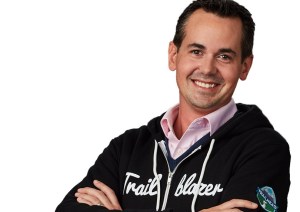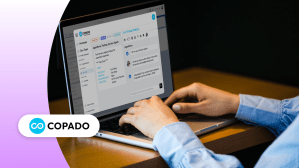Q&A: Chris Hoster, Head of Intuitive Surgical’s Center of Excellence, on Healthcare Innovation




nick.johnson@salesforce.com
Intuitive Surgical is a multi-billion dollar company that brings intelligent robotic technologies for healthcare to life. Its goal is to make surgery more effective, less invasive and easier on surgeons, patients and their families. The company develops and manufactures the da Vinci® Surgical System and other proprietary instruments that benefit a growing community of surgeons, hospitals, and patients.
Intuitive Surgical leverages Salesforce Sales Cloud and Marketing Cloud to accelerate its growth and drive better awareness and adoption of its products. In conjunction with this week’s HIMMS healthcare conference, we caught up with Chris Hoster, who runs Intuitive Surgical’s Center of Excellence to discuss the importance of driving new and different surgery types, and how to run a business more effectively using Salesforce.
Q: Can you give us a brief outline of what “minimally-invasive surgery” is?
A: Great question. Minimally-invasive surgery means that instead of one large incision, you can make multiple smaller incisions using a camera to visualize and address the defect in the patient. Laparoscopic surgery was the first to tackle this concept. And our mission as a company is to eradicate open surgery, which is where surgeons use large incisions and scalpels to address a defect in the patient, and replace it with minimally-invasive surgery.
Q: So why is this important?
A: All our data indicates that minimally-invasive surgery has a significant reduction in the ultimate trauma on the patient. Your ability to recover from three or four sub-one-inch incisions is far better than a major one, and that has follow-on impacts in terms of pain management, hospital stays, and complications from a patient perspective. From the hospital perspective, it helps provide a more uniform experience for the patient and reduces cost as well. Everybody benefits.
Q: If this is such a no-brainer, why do we still have open surgery?
A: The reason there is still open surgery is that traditional pre-robotic minimally invasive surgeries have a lot of limitations. Certain patient populations – such as obese patients, significantly advanced defects, or patients with previous surgeries haven’t traditionally been offered minimally-invasive surgery. That’s why we’re gaining traction – because we used robotics to help create the right experience for patients, surgeons and hospitals. And we have more than 4,100 robot-assisted units in use today.
Q: That’s a lot of robots. At Salesforce we frequently discuss the Fourth Industrial Revolution as a new beginning – complete with robotics, AI and IoT. From your perspective, do you think the Fourth Industrial Revolution will impact healthcare significantly?
Well, I believe the Fourth Industrial Revolution is actually going to impact every aspect of healthcare. Just looking at our area, I doubt many or even any surgeons believe that open – or even laparoscopic – surgery is the future for patients. Laparoscopic technology and techniques have been used 50-60 years or more and open surgery since the beginning. But it’s not just about surgery; I see the Fourth Industrial Revolution is really about managing a continuum of healthcare, preventative measures, even genomics to develop medicines based on your DNA. Also, when you look at it, there’s a wealth of data in terms of population data. The more data we have, the more information we have to make the quick decisions that are right for the patient and that benefit society as a whole.
Q: What are you seeing in the healthcare arena in terms of robotics? Any AI issues?
A: Well, one of the misnomers when people hear “robotic surgery” is that they assume that the robot is doing the surgery while the doctor is drinking a cup of coffee down in the cafeteria. It’s robotic-assisted surgery. The robot is right there by the patient, but it’s the surgeon that is manipulating the instrument – so the surgeon has better visibility and agility than in traditional surgery. So that’s one important thing to know. The robots aren’t taking over, at least not here.
As far as AI? We’ve not even scratched the surface yet. We have some complicated formulas and reporting mechanisms and data scientists who are able to make some estimates about our products and our future, but we haven’t crossed the chasm to real time recommendations based on that data yet.
Q: So why did you choose Salesforce?
We had 700 sales people, and our business was growing at high speeds and we started expanding at a rapid rate internationally. The types of procedures we supported with our da Vinci Surgical System had grown, our product portfolio had increased. And global growth brings with it significantly increased complexity – dealing with regulations, different types of health systems, and different process requirements. We were essentially measuring this on spreadsheets and we knew there were better ways to collaborate and react to market dynamics. And we wanted to move quickly to capture the market. So ultimately, the decision to move to Salesforce was an easy one.
Q: What was your adoption strategy? You’ve mentioned that you like to move fast.
At this point we’re fully deployed, with a roadmap to get to Lightning in early 2019. We took an interesting approach to adoption, because we took significant muscle out of our sales teams and brought them out of the field to help design Salesforce to match the way our teams in the field already thought about the process. They left their jobs – and they were really successful reps, so this was an interesting move – for 18 months and they helped us design the system with the users in mind and had skin in the game for the rollout.
Q: How was that rollout?
We essentially did a “light switch flip” at our annual sales meeting, where the entire sales org spent an entire day training on Salesforce. We then flipped the switch that day and haven’t looked back since.
Q: If you had to cite one Salesforce product or service that made this a success what would that be?
A: The products are terrific, but what made this work was Success Cloud, which was involved in every area, from our Customer Success Manager to the Accelerators that they offer to help in deployment and enhancement of process. Our Success Manager is part of my team now. We have bi-weekly working calls, quarterly success calls, and I’m never shy about picking up the phone and getting guidance and insights on how to do this. Accelerators were also critical. I took a somewhat unusual approach with the Designing a Center of Excellence Accelerator. I actually did it twice.
Q: OK, I’ll bite. Why did you do it twice?
A: To be honest, we’d read the stories that implementations aren’t always successful and I did not plan to be in that camp! And this accelerator was critical in setting us up for success. I wanted to do the first run straight off the shelf, allowing the experts on the team to help us understand governance for Salesforce designing center of excellence, I did twice – the first off the shelf, where the team helped us understand governance for Salesforce, making sure we were avoiding the pitfalls and setting ourselves up for success. Four months later, I ran it again and said to the architect, “I want to present to you guys what my approach is based on what you’ve shared with me and I want you to play devil’s advocate to make sure we’ve got it right, to make sure we’re tight in our support structure, adoption metrics, everything we need.
Q: What are some healthcare-specific challenges that really keep you up at night? Is Salesforce helping you with these?
A: We want to eradicate open surgery. It’s not in the patients’ or the hospitals’ best interest, and our technology helps both by offering an alternative. To do this, and support minimally invasive surgery, we need to be able to analyze and act on real-time data, and Salesforce helps us do that. Salesforce allows us to be fully data-driven on our communications, processes, products, and allows us to drive our business forward. Being completely honest, any time your business is directly affecting people’s lives and well-being, the stakes are simply higher.
Q: What kind of ROI are you seeing with Salesforce?
A: Pre-Salesforce, we believed that our procedure growth required a direct 1-1 relationship with the customers, and we supported that with incremental headcount. That meant that our clinical sales reps could only handle 225 booked procedures per quarter for each of their accounts. And so that was the baseline for resource planning, territory design, and everything else. But when we looked at it, that number hadn’t changed in five years. We didn’t want to be beholden to that number.
So using Salesforce, we were able to identify gaps in the process and found that lower-cost clinical resources could support some activities that our clinical sales reps were doing, leaving the higher-cost and higher-training clinical reps freer to interact with surgeons and do what they did best. And over the last two years, with Salesforce, we’ve scaled from that initial 225 number to more than 360 procedures per rep per quarter. And we’ve grown 17% globally in the past year, driven primarily by growth in primarily by growth in U.S. general surgery procedures and worldwide urologic procedures. There’s incredible potential to do more.
Q: OK – so what was your a-ha moment that led you to this role and what you do now?
A: It’s so exciting to be part of a company focused on improving patients’ lives and their well-being and knowing that the technology that your company is producing – and the processes and tools I’m able to support on a daily business to make that technology successful – helps impact patients’ lives positively. It’s a daily reinforcement that everyone at Intuitive Surgical is helping someone spend less time in the hospital, less time recovering from a traumatic event and a ultimately having a better experience – and a better life. And that’s worth working towards.
Q: And finally, when did you most feel like a Trailblazer?
A: Well, choosing Salesforce made sense. Everyone knew there was a better way to manage our business. And we matched the technology to the proposed strategy, thought process and vision. But to me, the value of technology isn’t about features and function and benefits. It’s when you’re really using it to help people be their best. Whether that’s connecting dots on how to optimize their time or more complex processes. So when we understand what they’re trying to achieve, the process and motivations and their challenges, and connecting with them on how they can be their best – and using Salesforce to support that every day? That’s when I feel like a trailblazer.
















